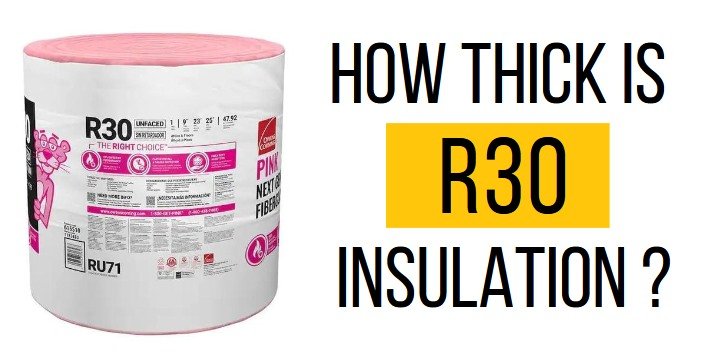Attic insulation, particularly fiberglass insulation, lowers utility costs throughout the winter and summer heating and cooling seasons. Additionally, certain types of insulation are made from recycled materials and other waste products, making them ecologically beneficial.
Depending on the attic’s design, intended use, budget, and personal preferences, homeowners can select from various insulation types.
How Thick is R30 Insulation?
For effective and easy insulation installation, use R-30 insulation, available at your local store or at least in your home’s ceiling. The insulation’s kind and substance will determine its thickness. If your ceiling is insulated, your energy costs will decrease; that much is clear.
Read also: How to Install Faced Insulation

It is crucial to consider the ceiling when insulating a room in your house. R-values evaluate a material’s resistance to heat transfer.
R-30 insulation, a type of insulation material, is advised as the bare minimum for ceilings, especially in hard-to-reach areas. The necessary thickness depends on the kind of insulation.
During my time working on various insulation projects, I have found that the specific type of insulation material greatly influences the overall effectiveness of the insulation. F
or instance, while working on an attic insulation project, I noticed that using multiple layers of polyiso with staggered joints significantly improved the insulation’s performance by reducing the risk of thermal bridging. This approach aligns with best practices in the industry to ensure optimal thermal resistance.
How Thick is R30 Attic Insulation?
The R30 insulation thickness you choose will affect your ability to reduce energy costs and enhance thermal resistance. Options like cellulose insulation and fiberglass offer varying degrees of thickness and moisture control. Understanding the appropriate R-value for different areas of your home is crucial to maximizing these benefits.
It is essential to use multiple layers of rigid foam insulation boards to avoid “cold” insulation joints. Staggering the joints of the boards enhances the thermal insulation system’s efficiency. For example, instead of using a single 5.2-inch thick polyiso board, two layers of 2.6 inches each, with staggered joints, should be used to improve performance.
The measurement of the materials is referred to as the R-value. A higher R-value means more energy efficiency.
Heat flows through different mechanisms, so it must be blocked to prevent heat migrations. Here’s how thick R30 insulation is.
| INSULATION MATERIAL TYPE | R30 INSULATION THICKNESS |
| Fiberglass | 8.25 inches |
| Open-cell Spray Foam | 9 inches |
| Closed-cell Spray Foam | 4.25 inches to 6 inches |
| Rigid Foam Board Insulation | 7.5 inches to 8.33 inches |
| Rock Wool Blown-in | 10.9 inches |
| Rock Wool Batt | 8.87 inches |
| Blown-in Fiberglass | 12.4 inches |
| Blown-in Cellulose | 9.3 inches. |
Moreover, when considering R30 insulation thickness, it’s important to factor in your home’s specific needs, including climate, moisture levels, and energy efficiency goals.
R30 insulation, known for its substantial thermal resistance, can play a pivotal role in maintaining a consistent indoor temperature and controlling moisture, which is especially important in areas prone to humidity.
By choosing the right insulation thickness, you can improve your home’s comfort and contribute to its overall energy efficiency.
Personal Experience:
I have personally observed that using multiple thinner layers of insulation with staggered joints instead of a single thick layer can greatly enhance the insulation efficiency. This practice, widely recommended by roofing professionals, helps prevent heat loss at the joints and provides a continuous insulation layer.
What Is R30 Insulation Used For?
The R-value of insulation, such as R30, measures a material’s thermal resistance, indicating its ability to resist heat transmission. A higher R-value means the material is more effective at controlling temperature and moisture within your home.
This implies that insulation with a high R-value will control your home’s temperature better than a low R-value material.
Consequently, maintaining a constant temperature in your house requires less effort from your heating and cooling system. In the end, a greater R-value results in lower energy expenses.
Is R30 Thicker Than R19?
A thicker R-value is required for a lower R-value. The R-value decreases with increasing material thickness, while the value of insulation increases with increasing R-value.
Can You Use R30 Insulation in the Walls?
The main goal of insulation is to hold air in situ to stop heat flow. There is a direct correlation between the insulation quantity and the heat transmission rate. Heat can also escape through wall insulation.
R13 to R23 are typical R-values for walls, whereas R30, R38, and R49 are preferred for ceilings and attic areas.
The proper material selection is crucial if you want to reduce heat conduction by 97%. After that, choose the necessary thickness from 4.25 to 12.4 inches. Its characteristics must meet the climatic zone and insulating capacity of your region.
Read also: How to Insulate a Garage Ceiling Rafters
How Thick is R30 Batt Insulation?
The term “R-value” refers to the measurement of the substance. More energy efficiency is correlated with a higher R-value. Since heat moves through several methods, it is essential to prevent potential heat migrations.
You will require a varied R-value depending on where you reside and the area of your home you are insulating (walls, crawlspace, attic, etc.). R-13 through R-23 is often recommended for external walls, whereas R-30, R-38, and R-49 are frequently used for ceilings and attic areas. Below are the suggested insulation levels from the Department of Energy (DOE).
Bottom Line
When considering R30 insulation, it’s important to understand that the thickness can vary depending on the insulation material used. For example, fiberglass insulation may have a different thickness than cellulose insulation.
Properly insulating your attic with R30 insulation can lead to significant energy savings and reduced heat loss, making your home more energy-efficient.
You have reached the final verdict on how thick R30 insulation is. You must insulate your ceiling if you want a home with good insulation. Insulation R-30 offers your home the least amount of heat transmission loss. Insulating your ceilings with R-30 will help you keep your energy costs down.

